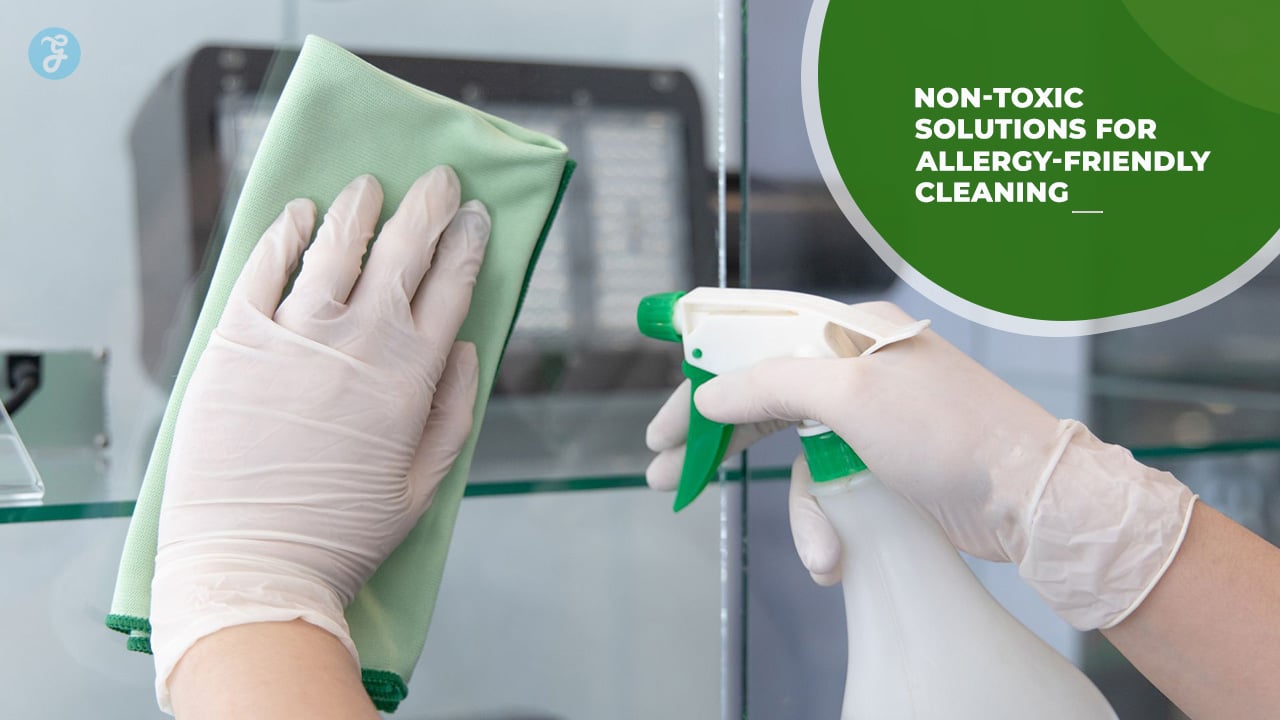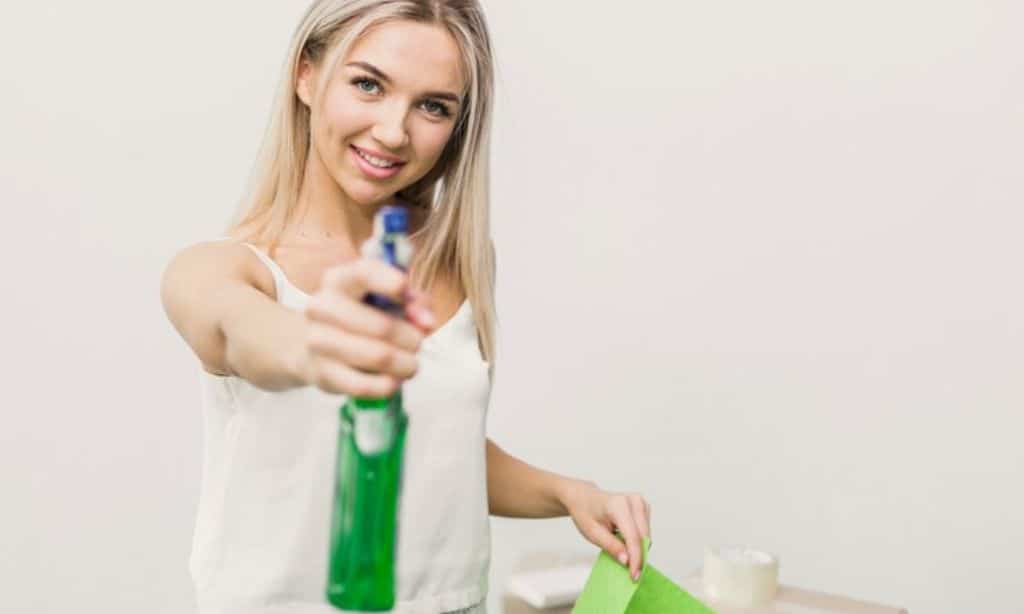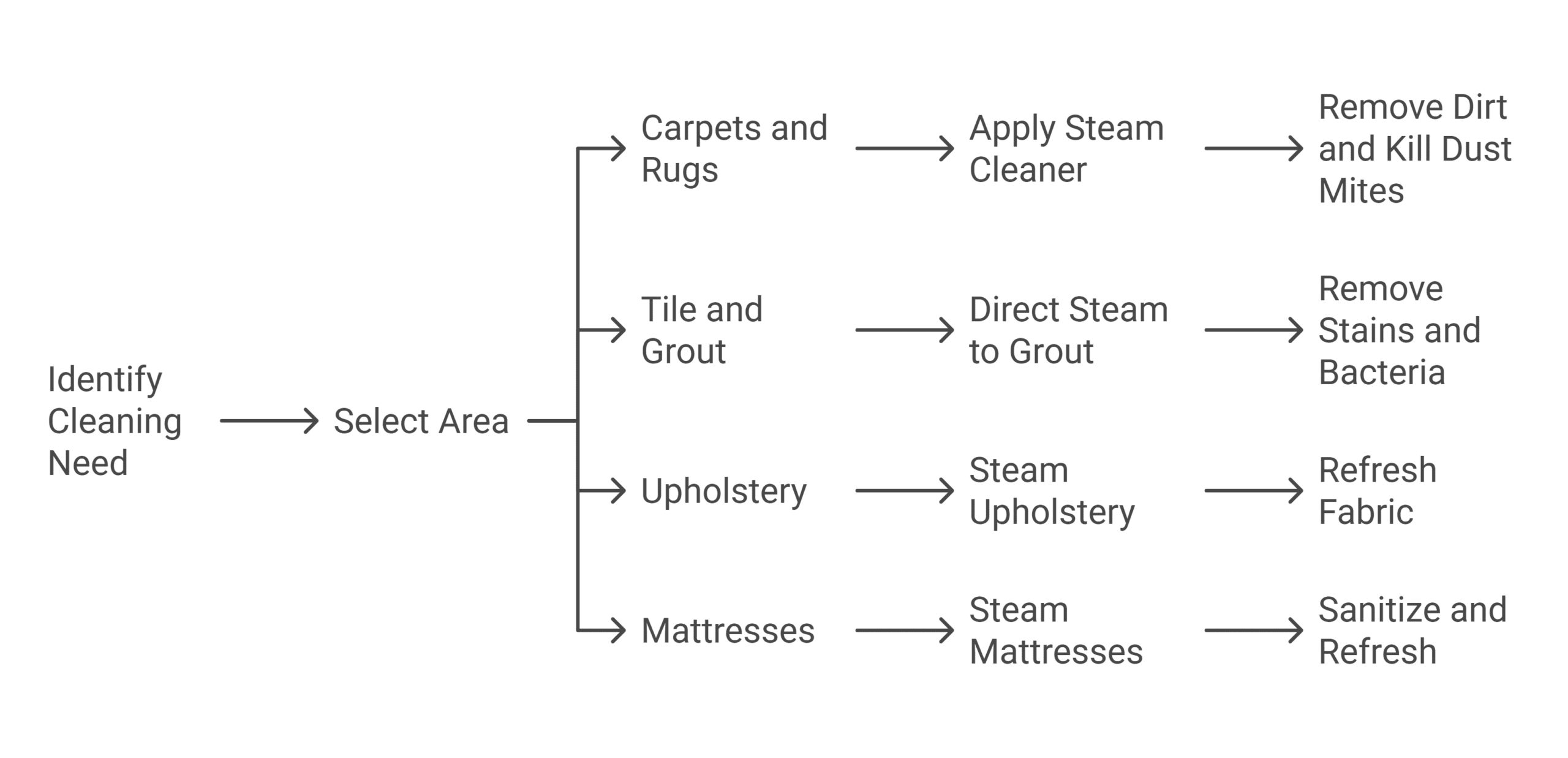Maintaining a clean home is essential for good health, but for those who suffer from allergies, traditional cleaning products can sometimes do more harm than good.
Harsh chemicals, synthetic fragrances, and allergens in conventional cleaning supplies can aggravate respiratory issues, cause skin irritation, and even trigger asthma attacks. Switching to non-toxic solutions for allergy-friendly cleaning is not only a healthier choice but also an environmentally responsible one.
In this guide, we’ll explore ten effective, non-toxic cleaning solutions and share tips to make your cleaning routine safer and allergy-friendly.
Why Choose Non-Toxic Solutions for Allergy-Friendly Cleaning?
We often prefer non-toxic solutions for allergy-friendly cleaning. But do we really know why? Let’s discuss.
The Health Risks of Conventional Cleaning Products
Traditional cleaning products often contain harmful chemicals like ammonia, formaldehyde, and volatile organic compounds (VOCs).
These substances can:
- Trigger respiratory issues such as asthma and bronchitis.
- Cause skin irritation and allergic reactions.
- Contribute to indoor air pollution, leading to long-term health risks.
Benefits of Non-Toxic Cleaning for Allergy-Prone Individuals
Switching to non-toxic solutions for allergy-friendly cleaning provides numerous benefits:
- Reduced exposure to allergens: Non-toxic cleaners are free of synthetic fragrances and harsh chemicals, making them safer for allergy sufferers.
- Healthier indoor environment: These cleaners help minimize indoor air pollution.
- Eco-friendly: Most non-toxic solutions are biodegradable and less harmful to the planet.
Key Features to Look for in Allergy-Friendly Cleaners
Check out the key features of non-toxic solutions for allergy-friendly cleaning.
Understanding Non-Toxic Labels
Navigating product labels can be tricky. Here’s what to look for:
- Fragrance-free: Avoid products labeled “scented” or “fragrance-enhanced.”
- Plant-based ingredients: Choose cleaners derived from natural sources like citrus or coconut.
- Certifications: Look for labels like EPA Safer Choice, Ecologo, or Green Seal to ensure the product meets safety and environmental standards.
Common Ingredients to Avoid
To ensure your cleaning routine aligns with non-toxic solutions for allergy-friendly cleaning, steer clear of:
- Synthetic fragrances: These can trigger headaches and allergies.
- VOCs: Found in air fresheners, aerosols, and disinfectants.
- Phthalates and parabens: Often used as preservatives but linked to health concerns.
Top 10 Non-Toxic Solutions for Allergy-Friendly Cleaning
Here are our top 10 selection of non toxic solutions for allergy friendly cleaning.
1. Baking Soda
Baking soda is a versatile and affordable cleaning agent that has been used for generations. Its natural properties make it a powerful deodorizer, stain remover, and mild abrasive for scrubbing tough stains. Unlike harsh chemicals, baking soda is safe for both humans and pets.
Here are some practical uses:
- Sprinkle it on carpets to absorb odors before vacuuming.
- Create a paste with water to clean sinks, grout, and countertops.
- Add it to laundry as a natural detergent booster.
Key Details Table:
| Use Case | Method | Benefits |
| Carpet deodorizing | Sprinkle, let sit 15 mins, vacuum | Neutralizes odors |
| Scrubbing tough stains | Mix with water to create a paste | Gentle yet effective cleaning |
| Laundry booster | Add 1/2 cup to washing machine | Enhances cleaning, removes odors |
2. White Vinegar
White vinegar is a natural disinfectant and degreaser, making it a go-to solution for a variety of cleaning tasks. Its high acidity helps break down grease, dissolve mineral deposits, and kill bacteria and mold. Whether you’re cleaning windows or deodorizing drains, white vinegar is a staple for allergy-friendly cleaning.
- Clean windows and mirrors for streak-free results.
- Remove hard water stains in bathrooms and kitchens.
- Deodorize kitchen drains and garbage disposals.
Key Details Table:
| Use Case | Method | Benefits |
| Window cleaning | Mix 1:1 with water, spray, and wipe | Streak-free shine |
| Hard water stains | Soak area with vinegar, scrub gently | Dissolves mineral deposits |
| Drain deodorizing | Pour vinegar, followed by baking soda | Eliminates odors naturally |
3. Castile Soap
Made from vegetable oils, Castile soap is a biodegradable and non-toxic cleaner that can replace multiple conventional products. Its gentle nature makes it suitable for surfaces, dishes, and even personal care. It’s free from synthetic detergents and animal products, aligning perfectly with eco-friendly cleaning goals.
- Dilute it with water to clean floors and countertops.
- Use it as a natural dish soap or laundry detergent.
- Mix with essential oils for a fragrant, personalized cleaner.
Key Details Table:
| Use Case | Method | Benefits |
| Floor cleaning | Dilute 1/4 cup in a gallon of water | Gentle and effective |
| Dishwashing | Use directly or mix with warm water | Cuts grease without harsh chemicals |
| DIY cleaner base | Mix with water and essential oils | Customizable and multi-purpose |
4. Hydrogen Peroxide
Hydrogen peroxide is a natural and powerful disinfectant that tackles bacteria, mold, and viruses. Unlike bleach, it’s safe for allergy-prone individuals and doesn’t emit harmful fumes. Hydrogen peroxide is ideal for sanitizing high-touch areas and removing mold from surfaces.
- Sanitize cutting boards, countertops, and bathroom surfaces.
- Remove mildew from shower tiles and grout.
- Disinfect toys and other household items.
Key Details Table:
| Use Case | Method | Benefits |
| Surface sanitizing | Spray undiluted, let sit, wipe clean | Kills bacteria and viruses effectively |
| Mold removal | Apply to affected areas, scrub gently | Removes and prevents mildew growth |
| Toy cleaning | Spray, rinse with water after cleaning | Safe for children’s items |
5. Lemon Juice
Lemon juice is a natural antibacterial agent with a fresh, uplifting scent. It’s ideal for removing stains, shining surfaces, and neutralizing odors. Beyond cleaning, it leaves a refreshing natural aroma that’s safe for allergy sufferers.
- Remove stains from cutting boards and fabrics.
- Shine chrome fixtures and kitchen appliances.
- Neutralize odors in refrigerators and garbage disposals.
Key Details Table:
| Use Case | Method | Benefits |
| Stain removal | Apply directly, scrub or soak | Eliminates tough stains naturally |
| Fixture shining | Rub with lemon wedge, rinse with water | Restores shine to chrome and steel |
| Odor neutralizing | Place lemon peels in disposal, grind | Freshens kitchen naturally |
6. Essential Oils
Essential oils such as tea tree, lavender, and eucalyptus offer antimicrobial properties and add pleasant scents to your cleaning routine. However, it’s essential to use them sparingly to avoid triggering sensitivities. They’re perfect for enhancing DIY cleaning solutions or freshening the air naturally.
- Add a few drops to vinegar-based cleaning sprays.
- Use in a diffuser to freshen indoor air.
- Mix with baking soda for a natural carpet deodorizer.
Key Details Table:
| Essential Oil | Cleaning Use | Additional Benefits |
| Tea Tree | Mold removal, disinfecting | Antibacterial and antifungal |
| Lavender | Air freshening, mild disinfecting | Calming aroma |
| Eucalyptus | Bathroom cleaning, air freshening | Refreshing and antimicrobial |
7. Microfiber Cloths
Microfiber cloths are highly effective for trapping dust, allergens, and dirt without requiring chemical cleaners. Their unique fibers can clean delicate surfaces without scratching and are reusable, making them an eco-friendly option.
- Dust surfaces like shelves and electronics.
- Clean windows and mirrors without streaks.
- Remove smudges from stainless steel appliances.
Key Details Table:
| Use Case | Method | Benefits |
| Dusting | Use dry or damp to capture particles | Traps allergens effectively |
| Glass cleaning | Use damp for streak-free results | Eliminates need for chemical sprays |
| Appliance cleaning | Wipe with damp cloth | Safe for delicate finishes |
8. Plant-Based Commercial Cleaners
Plant-based commercial cleaners are readily available, offering a balance between convenience and eco-friendliness. Many brands have developed non-toxic formulas designed to clean effectively without harmful chemicals.
Popular options include:
- Method
- Seventh Generation
- Mrs. Meyer’s Clean Day
These cleaners are biodegradable, allergy-friendly, and safe for both children and pets. They’re suitable for everyday cleaning tasks, from wiping surfaces to tackling tough stains.
Key Details Table:
| Brand | Key Features | Ideal For |
| Method | Plant-based, biodegradable, gentle scents | General household cleaning |
| Seventh Generation | Free of dyes and synthetic fragrances | Allergy-prone individuals |
| Mrs. Meyer’s Clean Day | Aromatherapeutic cleaning products | Eco-conscious users |
9. Steam Cleaning
Steam cleaning is a chemical-free method that uses high-temperature steam to sanitize and remove dirt, allergens, and bacteria. It’s particularly effective for deep-cleaning carpets, upholstery, and mattresses. The heat not only cleans but also kills dust mites, mold spores, and other allergens, making it ideal for allergy sufferers.
- Use on carpets and rugs to remove embedded dirt.
- Clean grout and tiles in kitchens and bathrooms.
- Refresh upholstery and sanitize mattresses.
Key Details Table:
| Use Case | Method | Benefits |
| Carpet cleaning | Use steam cleaner over surface | Removes dirt, kills dust mites |
| Tile and grout cleaning | Direct steam to grout lines, scrub lightly | Removes stains and bacteria |
| Mattress sanitizing | Steam across surface, let dry completely | Kills allergens and refreshes fabric |
10. DIY Cleaning Sprays
DIY cleaning sprays are easy to make and allow complete control over ingredients, ensuring they’re safe and non-toxic. A simple recipe combines vinegar, water, and essential oils for an effective, multi-purpose cleaner. Adjust ingredients for specific tasks like glass cleaning or disinfecting.
- Mix 1 cup of white vinegar, 1 cup of water, and 10 drops of essential oil.
- Store in a spray bottle for convenient use.
- Use for cleaning glass, countertops, and more.
Key Details Table:
| Recipe | Ingredients | Ideal Use |
| Multi-purpose spray | Vinegar, water, essential oils | General surface cleaning |
| Glass cleaner | Vinegar, water | Streak-free window cleaning |
| Disinfectant | Vinegar, hydrogen peroxide, tea tree oil | Killing germs on high-touch areas |
How to Create an Allergy-Friendly Cleaning Routine
Tips for Reducing Allergens in Your Home
- Dust regularly: Use microfiber cloths to trap dust instead of spreading it around.
- Vacuum with a HEPA filter: These vacuums are designed to capture allergens.
- Wash linens frequently: Hot water helps eliminate dust mites and other allergens.
Best Practices for Using Non-Toxic Cleaners
- Test for sensitivities: Try new products on a small area to ensure they’re safe for everyone in your home.
- Proper storage: Keep cleaning solutions in labeled, child-proof containers.
- Ventilate while cleaning: Open windows to ensure good air circulation.
Takeaways
Switching to non-toxic solutions for allergy-friendly cleaning is a small change that can make a big difference in your home’s health and safety. These alternatives reduce exposure to harmful chemicals, improve indoor air quality, and provide peace of mind for allergy sufferers.
By adopting these simple yet effective cleaning methods, you’ll create a healthier living environment for you and your family. Start today with non-toxic solutions for allergy-friendly cleaning and experience the benefits of a cleaner, greener, and allergy-friendly home!







































